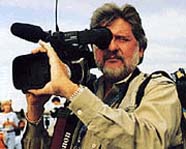|
Some Truths
About |
 |
|
In his interview for this month's cover story on Stars and Stripes, John Olson recounts his remarkable odyssey as a 19-year-old draftee in Vietnam - from winning the Robert Capa Gold Medal, after his first year there, to becoming - only a few months later - a staff photographer for Life Magazine. He had to fight to be sent to Vietnam by the Army; once there, he had to fight to be sent to the battlefields. He was probably one of the few people in the American military to set foot in all three of the biggest battlefields during the Tet offensive in 1968. He was cocky, manipulative, and brave. His story tells us a lot about what photographers in combat are like. In many ways they are counter-intuitive, venturing into the most dangerous situations, when everyone else - who possibly can - is trying to get out. Many photographers develop their own particular ways of dealing with the chaos and death surrounding them. Some become detached from the reality of the battlefield by using the viewfinder as a way to block and immunize themselves against the madness. Others develop weird and bizarre behavior patterns. The medics in M*A*S*H, or the mad photographer played by Dennis Hopper in Apocalypse Now, come to mind. People like these characters really did exist. In some ways, from
the journalist's perspective, the wars have gotten a lot tougher since
Vietnam. The siege of Sarajevo and the ethnic cleansing of Kosovo offered
few creature comforts for journalists covering them, unlike the Sodom
and Gomorrah atmosphere of Saigon to which one could always retreat
from the combat zones. Africa could be a horror, as photographers like
Don McCullin can attest. However, during some of the worst shelling
in Somalia, TV cameraman Rolf Behrens developed a reputation for his
sangfroid, being dubbed the "Chef of Mogadishu," as he prepared
barbecues on the roof of the press hotel during fire fights. Some go out of a sense of duty and commitment, others go to enhance their careers - or to start them, and still others go because they love the adrenaline rush, the charge into danger, the intensity of watching and photographing mankind when the starkest realities occur. Then, the equal thrill of escape, the return to sanctuary - the food, the drink, the friends. And perhaps...yes, perhaps even the sex, that comes with the sweet aroma of just, still, being alive.
|
|
|
ARCHIVES
| PORTFOLIOS
| LINKS |
|
Read
Dirck Halstead's previous |